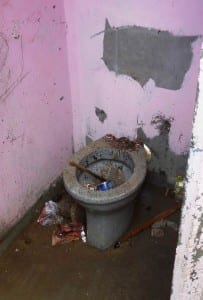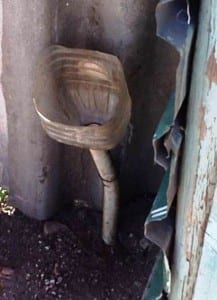Preparation Research
Globally, two billion people live in slums, shantytowns, and informal settlements near major cities. These areas often lack many forms of city planning, from standardized streets, to storm water management, to access to clean water and safe sanitation. In Cape Town, the situation is no different. Cape Town is home to an estimated 3.75 million people, with over two hundred informal settlements around Cape Town containing 194,000 households (Gontsana, 2013).
Before 1994, about half of the people living in South Africa lacked proper health and sanitation facilities. During the apartheid era, there had been a neglect of infrastructure that served non-white populations. When the African National Congress (ANC) took control in 1994, the new government passed laws and created new policies to improve conditions in infrastructure. Beginning with the new constitution, which states that access to basic health and sanitation is a human right, legislation began regulating the requirements for basic water and sanitation (Tissington, 2011). Local governments and municipalities have been working hard in the last fifteen years to effect change in communities.
Government & non-governmental organisation (NGO) efforts to improve water, sanitation, and hygiene (WaSH) facilities in South Africa and other developing countries have demonstrated key principles of a sustainable facility. These principles are multi-stakeholder involvement, multipurpose of the facility, and community driven efforts to construct and maintain such a facility (Overton et al., 2012). In addition, effective WaSH
centres strike a balance of environmental, social, economical, and institutional sustainability. For example, in 2007 the WPI Cape Town Project Centre included a water and sanitation project that designed and implemented a laundry and washing station in Monwabisi Park. The group developed community involvement strategies and performed interviews before designing and implementing the laundry facility. The finished product met and exceeded the group’s expectations, and received positive reactions from the benefiting community (CTPC, 2007). The community’s extensive involvement in the development of this facility resulted in social and institutional sustainability of the laundry station. Two WaSH projects later, a team of WPI students planned a water and sanitation facility in Monwabisi Park that included urine divergent and composting toilets, improved water taps, and a laundry station (CTPC, 2009). In utilising this cost efficient and eco-friendly technology, the project team implemented effective economic and environmental sustainability. These two WPI projects illustrate an effective balance of the aspects of sustainability tha ensured the success of their efforts.
Other case studies in developing countries have also shown that successful WaSH projects typically involve community collaboration and solutions that are environmentally and economically sustainable. In Maharashtra, India for example, of twelve different water and sanitation projects assessed, those that had more input from NGOs and the communities tended to be more widely accepted and overall more successful than projects that were primarily government run (Brunner, 2010). Studies conducted in Bwaise III, Uganda showed that environmentally sustainable technology such as urine divergent toilets in WaSH facilities could be more effective in maintaining hygiene and conserving resources when properly used (Katukiza, 2010). Projects that incorporate both the social sustainability of community involvement as well as environmentally and economically sustainable technology are therefore more likely to be institutionally sustainable. That is, a facility that utilizes a balance of sustainable methods such as those used in India and Uganda should be able to support itself and thrive as a centre.
Although there have been several successful WaSH efforts in the informal settlements of Cape Town, there is a constant need for growth, expansion, and replication of these facilities to fill the needs of each community which can vary due to location and different available resources. The 2012 WPI WaSH project, conducted with CORC (Community Organisation Resource Centre) in Langrug highlighted some key challenges that can arise in the development of WaSH facilities. The project overall contained elements for success, including multiple stakeholders involved in plans for a multipurpose community centre that would be integrated with basic water and sanitation facilities. However, lack of communication between the local government and the community resulted in conflicts over the funding and maintenance of the centre (CTPC, 2012). Though the water and sanitation portion of the multipurpose facility has been operational since the community working team completed construction in early 2013, there are areas to be improved in the WaSH centre and in the process of creating such a facility. The 2012 project illustrated that all stakeholders must be fully invested in such an effort, and that proper management of the construction process ought to be a key consideration in future facilities. Additionally, the components necessary for a successful WaSH centre depend upon the location and resources available at the site. For instance, the facility in Langrug was able to incorporate flush toilets since access to water and a sewer line were available. This may not be the case in other settlements where lack of such resources make dry sanitation methods necessary. Unfortunately, there is no standard strategy for the implementation of an ideal successful WaSH facility.
In an effort to guide future WaSH efforts toward success, our project will assess the effectiveness of current water and sanitation facilities in the Cape Town area, and develop strategies for CORC and other stakeholders seeking to improve and implement such WaSH facilities as sustainable centrepieces in community upgrading. The team will begin by assessing the facilities developed with the Cape Town Project Centre in Langrug and Monwabisi Park: usage, cost of construction and maintenance and as community acceptance. Based on this data, the team will propose improvements that could be made in the established centres and in future multipurpose WaSH facilities throughout Cape Town. This analysis will also include an assessment of the role of a caretaker in a multipurpose WaSH centre. In addition, this project will explore alternative designs for WaSH infrastructure such as toilets, taps, and aesthetic factors, and will potentially create prototypes for select designs. Compiling such information and technical considerations, the team will develop a guide for WaSH facilities in informal settlement upgrading and create a plan to implement smaller facilities so that future stakeholders can provide the best possible water sanitation and hygiene structures to the maximum number of people.




